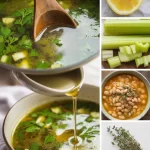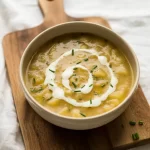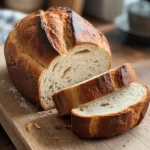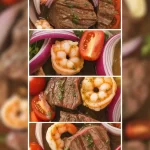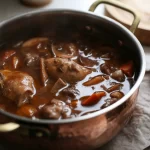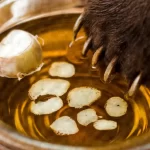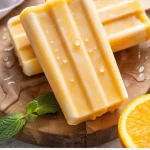Prepare to embark on a culinary adventure as I walk you through the art of creating perfectly roasted duck breast with a tantalizing glaze that dances between sweet, savory, and utterly irresistible.
Creating the perfect balance of flavors in my roasted duck fillet recipe is something I adore. Duck breast fillets have a richness that really comes into play with simple seasoning of salt and freshly ground black pepper, paired with aromatic minced garlic and fresh thyme.
A glaze of balsamic vinegar, honey, and soy sauce bounces this dish right into the stratosphere of sweet ‘n’ tangy. I think this dish is both delicious and an elegant option, packed with protein and flavors that complement each other beautifully.
Roasted Duck Fillet Recipe Ingredients
- Duck Breast Fillets: Rich in protein, tender, and flavorful meat.
- Olive Oil: Heart-healthy fat, adds richness and depth.
- Garlic: Aromatic, boosts flavor, and offers health benefits.
- Thyme: Herbaceous, earthy, adds a fresh note.
- Balsamic Vinegar: Tangy, adds a sweet and sour depth.
- Honey: Natural sweetener, balances flavors.
- Soy Sauce: Salty, umami-rich, enhances flavor.
Roasted Duck Fillet Recipe Ingredient Quantities
- 2 duck breast fillets
- Salt, to taste
- Freshly ground black pepper, to taste
- 1 tablespoon olive oil
- 2 cloves garlic, minced
- 1 tablespoon fresh thyme leaves
- 1 tablespoon balsamic vinegar
- 1 tablespoon honey
- 1 tablespoon soy sauce
How to Make this Roasted Duck Fillet Recipe
1. Set your oven to 400°F (200°C) to preheat.
2. Using a paper towel, dry the duck breast fillets. Using a sharp knife, score the skin of each fillet in a crisscross pattern. Be careful not to cut into the meat.
3. Sprinkle salt and fresh black pepper equally on both sides of the duck fillets. Seasoning the duck well is essential because duck breast meat is quite rich and can stand up to a good amount of seasoning.
4. Preheat an oven-safe skillet over medium-high heat and then add olive oil. When the duck fat is rendered and both the skin and meat sides are golden brown, pour off any excess fat (reserve it for cooking potatoes or other vegetables) and set the skillet aside.
5. Sear the duck fillets for about 4-5 minutes, or until the skin is golden brown and crispy. Flip the fillets and sear the other side for 2-3 minutes.
6. Move the skillet to the preheated oven and roast for 8-10 minutes for medium-rare, or longer if you desire it more done.
7. As the duck roasts, combine minced garlic, fresh thyme leaves, balsamic vinegar, honey, and soy sauce in a small bowl to create the sauce.
8. Take the skillet out of the oven, and move the duck fillets to a cutting board. They should rest for about 5 minutes.
9. Prepare the sauce in the same skillet over medium heat, for a duration of 2-3 minutes. Stir sauce consistently and frequently to ensure it thickens evenly and slightly.
10. Cut the duck fillets into thin slices and place them on a serving platter. Lightly drizzle with sauce just before serving. Enjoy your roasted duck fillet.
Roasted Duck Fillet Recipe Equipment Needed
1. Oven
2. Paper towels
3. Sharp knife
4. Cutting board
5. Salt and pepper grinder or shakers
6. Oven-safe skillet
7. Medium bowl
8. Spoon or whisk for mixing
9. Tongs (for flipping the duck)
10. Serving platter
FAQ
- How do I know when the duck is cooked?The duck achieves the state of “cooked” when it reaches an internal temperature of 135°F (57°C) for medium rare. For accuracy, use a meat thermometer.
- Can I use dried thyme instead of fresh?It is indeed possible to use dried thyme as a substitute. However, use only half the amount, since dried herbs are more potent in flavor.
- What should I serve with roasted duck fillet?Duck fillet, when roasted, makes a splendid match with sides of fluffy mashed potatoes, bright steamed vegetables, or a simply dressed salad.
- How do I prevent the duck from drying out?Make sure the duck isn’t cooked too long by keeping an eye on the internal temperature and letting the bird rest for a few minutes after it comes out of the oven. Slicing into the duck too soon will result in a lot of juice running out.
- Can I use a pan instead of the oven?Yes, you can sear the duck fillets, skin-side down, on a stovetop over medium heat until crispy. Then finish by basting with the sauce ingredients.
- Is there a substitute for balsamic vinegar?Instead of balsamic vinegar, you can use red wine vinegar mixed with a touch of sugar to approximate the same level of sweetness.
- Can I marinate the duck in advance?Marinating the duck with the garlic, thyme, and sauces for a few hours can boost the flavor, but it’s not required.
Roasted Duck Fillet Recipe Substitutions and Variations
Substitute kosher salt or sea salt for a slightly different texture and flavor.
Coarsely ground black pepper: Substitute with white pepper for a milder, less penetrating flavor.
Avocado oil or vegetable oil can be used in place of olive oil, as these oils have a neutral flavor.
Thyme leaves freshly picked: Dried thyme leaves may be used in their place. One half the amount of dried thyme as compared to fresh use is recommended. Alternatively, fresh rosemary may bring a different but equally pleasing herbaceous note.
Red wine vinegar mixed with a pinch of sugar for sweetness is an acceptable substitute for balsamic vinegar. So is apple cider vinegar done in the same way.
Pro Tips
1. Rendering the Fat: Start with the duck breasts skin-side down in a cold skillet. This helps render the fat more effectively and ensures a crispy skin.
2. Scoring the Skin: When scoring the skin, try to score it deeply enough to penetrate the fat but not too deep to cut into the meat. This maximizes fat rendering and crispiness.
3. Use Reserved Duck Fat: The duck fat you pour off after searing is excellent for roasting vegetables or frying potatoes. It adds a delicious flavor boost to side dishes.
4. Let Rest Properly: Allow the duck to rest after roasting for at least 5 minutes. This ensures the juices redistribute throughout the meat, resulting in a juicier, more flavorful duck.
5. Adjust Seasoning for Sauce: Taste the sauce while it cooks and adjust seasoning as necessary. Depending on your preference, you might add a pinch of salt, extra honey for sweetness, or more balsamic vinegar for acidity.
Roasted Duck Fillet Recipe
My favorite Roasted Duck Fillet Recipe
Equipment Needed:
1. Oven
2. Paper towels
3. Sharp knife
4. Cutting board
5. Salt and pepper grinder or shakers
6. Oven-safe skillet
7. Medium bowl
8. Spoon or whisk for mixing
9. Tongs (for flipping the duck)
10. Serving platter
Ingredients:
- 2 duck breast fillets
- Salt, to taste
- Freshly ground black pepper, to taste
- 1 tablespoon olive oil
- 2 cloves garlic, minced
- 1 tablespoon fresh thyme leaves
- 1 tablespoon balsamic vinegar
- 1 tablespoon honey
- 1 tablespoon soy sauce
Instructions:
1. Set your oven to 400°F (200°C) to preheat.
2. Using a paper towel, dry the duck breast fillets. Using a sharp knife, score the skin of each fillet in a crisscross pattern. Be careful not to cut into the meat.
3. Sprinkle salt and fresh black pepper equally on both sides of the duck fillets. Seasoning the duck well is essential because duck breast meat is quite rich and can stand up to a good amount of seasoning.
4. Preheat an oven-safe skillet over medium-high heat and then add olive oil. When the duck fat is rendered and both the skin and meat sides are golden brown, pour off any excess fat (reserve it for cooking potatoes or other vegetables) and set the skillet aside.
5. Sear the duck fillets for about 4-5 minutes, or until the skin is golden brown and crispy. Flip the fillets and sear the other side for 2-3 minutes.
6. Move the skillet to the preheated oven and roast for 8-10 minutes for medium-rare, or longer if you desire it more done.
7. As the duck roasts, combine minced garlic, fresh thyme leaves, balsamic vinegar, honey, and soy sauce in a small bowl to create the sauce.
8. Take the skillet out of the oven, and move the duck fillets to a cutting board. They should rest for about 5 minutes.
9. Prepare the sauce in the same skillet over medium heat, for a duration of 2-3 minutes. Stir sauce consistently and frequently to ensure it thickens evenly and slightly.
10. Cut the duck fillets into thin slices and place them on a serving platter. Lightly drizzle with sauce just before serving. Enjoy your roasted duck fillet.





